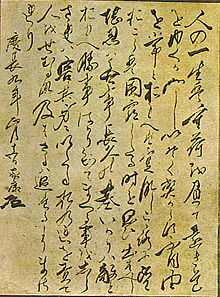Testament of Ieyasu
From Wikipedia, the free encyclopedia

Precepts on the secret of success in life drafted by Tokugawa Ieyasu from the collection of Nikkō Tōshō-gū.
Testament of Ieyasu (東照宮御遺訓 Tōshō-gū goikun),[1] also known as Ieyasu precepts or Legacy of Ieyasu,[2] was a formal statement made by Tokugawa Ieyasu.[3]
History
Ieyasu was the head of the Tokugawa shogunate. His words were spoken and written down at the time of his abdication as shogun. Witnesses included Honda Masazumi (1565-1637) and two Buddhist priest.[4] The original historical document is in the archives of the Tōshō-gū shrine at Nikkō in Tochigi Prefecture.[5]
This political statement provided guidance to his successors.[2]
Translation
A translation of Ieyasu's words is:
- "Life is like walking along a long road shouldering a heavy load; there is no need to hurry.
- One who treats difficulties as the normal state of affairs will never be discontented.
- Patience is the source of eternal peace; treat anger as an enemy.
- Harm will befall one who knows only success and has never experienced failure.
- Blame yourself rather than others.
- It is better not to reach than to go too far." --Tokugawa Ieayasu, 1604.[6]
An alternate translation is:
- Life is like carrying a heavy burden:
- It is best not to rush ahead too hastily.
- He who accepts it as natural for life not to go exactly how he wants it to will not feel dissatisfied.
- Rather than doing too much, it is best to leave things undone.
- When managing others, give full reign to their good points and overlook their weak points. --Tokugawa Ieyasu, 1604.[7]
References
- ↑ McMullen, James. (1999). Idealism, Protest, and the Tale of Genji: The Confucianism of Kumazawa, p. 52.
- ↑ 2.0 2.1 Chamberlain, Basil Hall and W. B. Mason. (1901). A Handbook for Travellers in Japan, p. 74.
- ↑ Kisala, Robert. (1999). Prophets of Peace: Pacifism and Cultural Identity in Japan's New Religions, p. 19.
- ↑ Gerhart, Karen M. (1999). The eyes of power: art and early Tokugawa authority, p. 169.
- ↑ Nikkō Tōshō-gū shashinsho. Tochigi-ken Kamitsuga-gun Nikkō-cho: Bekkaku Kanpeisha Tōshō-gū Shamusho, 1934; retrieved 2013-1-16.
- ↑ OldTokyo.com: Tōshō-gū Shrine
- ↑ The Japan Project: The Tokugawa Shogunate. The American Forum for Global Education.
This article is issued from Wikipedia. The text is available under the Creative Commons Attribution/Share Alike; additional terms may apply for the media files.